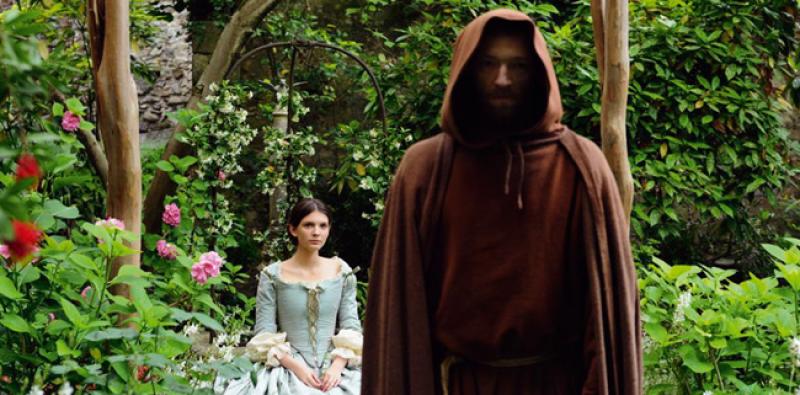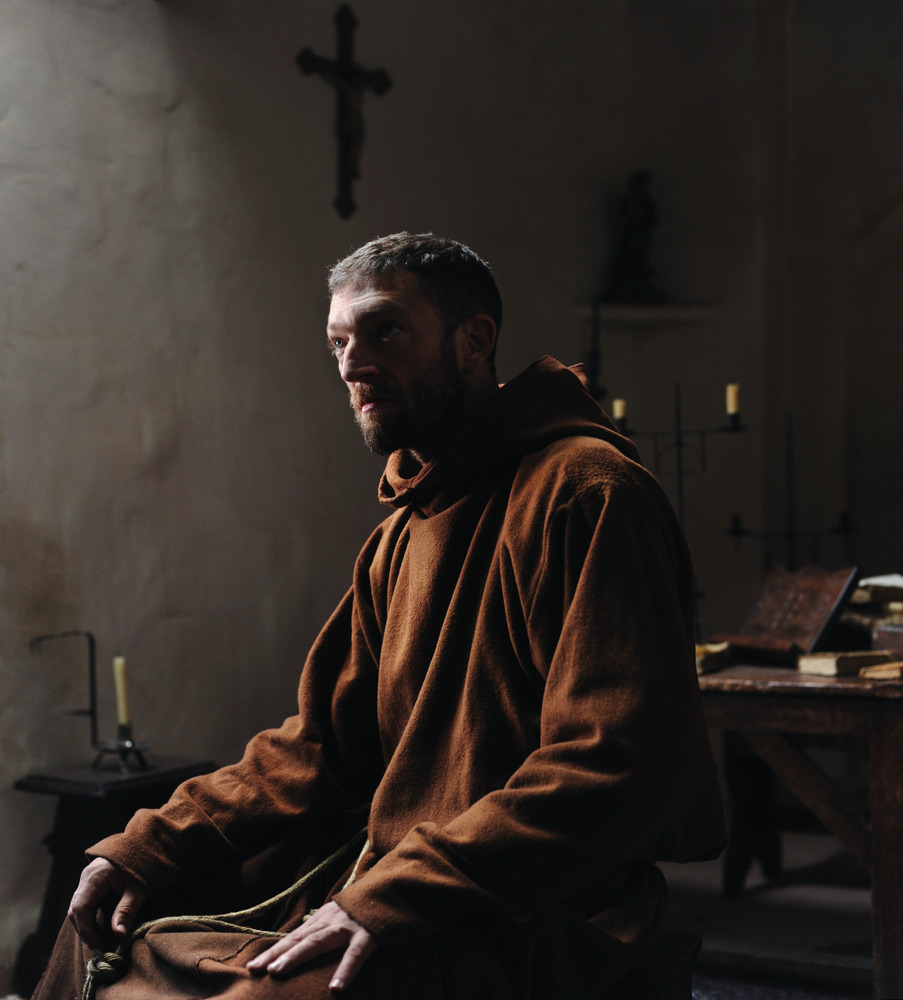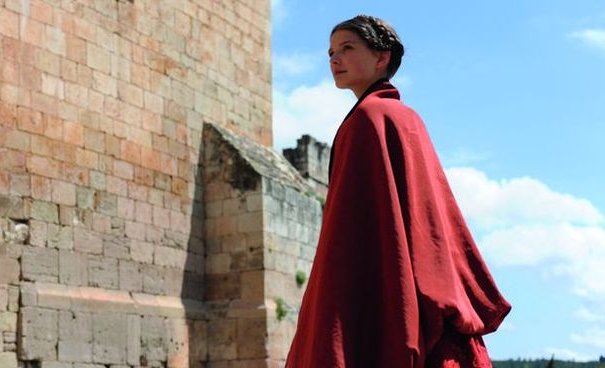Le Moine | reviews, news & interviews
Le Moine
Le Moine
It'll take more than few Hail Marys to redeem this tepid religious fable

Incest, rape, torture and matricide, as well as an obligatory spot of cross-dressing, all played their part in making Matthew Lewis’s Gothic novel The Monk the scandalous success of its day. But with such stuff the bread and butter of Hollywood’s unblinking horror departments, why would a contemporary director choose to revisit this period classic? It was apparently a lifelong ambition of Surrealism’s greatest filmmaker Luis Buñuel to adapt The Monk for the screen.
Buñuel’s own project may have been abandoned, but his skeleton script was taken up by director Adonis Kyriou for a 1972 adaptation that has all but disappeared from cinematic memory (along with an equally undistinguished 1990 version starring Paul McGann). The Monk then has proved something of a problem on film – unexpected, given the novel’s sensationalist aesthetic, and its screenworthy cast of seductive temptresses, beauteous virgins, naughty nuns and of course a wicked(ly charismatic) priest.
There are some superb films of faith in crisis which push further and dare more than this polite little fable
Played in this latest adaptation by French plat du jour Vincent Cassel (Mesrine, A Dangerous Method), preacher-turned-sinner Father Ambrosio (pictured below) offers just about the only reason to go and see this pallid and laborious piece of cinema. Director Dominik Moll has managed to turn a large budget and a gripping plot into quite the least thrilling hour and a half imaginable – a conjuring trick far more devilish than anything we actually witness on screen.
Torn between a quiet art-house meditation on faith, the social implications of organised religion and the nature of obsession, and an all-out, ravens-on-the-battlements, devil-worshipping, Spanish-Inquisitioning piece of Gothic shock-and-awe, the film dithers visibly. Having confessed itself, rather unwillingly, of a few gruesome little moments, it returns to the safe-ground of bleached Spanish landscapes and functional interior action sequences.
 Despite cutting acres of sub-plot and a few characters, the film’s 90 minutes manage both to rush their exposition and drag in their drama. With the early death of fallen-nun Agnes (Roxane Duran) we lose the only fully-developed female of the story, and not even the poised beauty of Josephine Japy’s Antonia (pictured below) can make up for Deborah Francois’s rather undercooked devil-in-disguise Valerio (Matilda/Rosario of the original – here transformed from beautiful novice to masked burn-victim).
Despite cutting acres of sub-plot and a few characters, the film’s 90 minutes manage both to rush their exposition and drag in their drama. With the early death of fallen-nun Agnes (Roxane Duran) we lose the only fully-developed female of the story, and not even the poised beauty of Josephine Japy’s Antonia (pictured below) can make up for Deborah Francois’s rather undercooked devil-in-disguise Valerio (Matilda/Rosario of the original – here transformed from beautiful novice to masked burn-victim).
All Gothic horror needs some Enlightenment rationalism (however flawed) to kick against, and perhaps a more spacious narrative, leaving room to develop the novel’s most terrifying element – the sadism that lies at the extreme reaches of religious devotion – might have proved more satisfying. By shedding the politics and much of the social context of the action, Moll situates his pretty period action in a vacuum, losing the all-too real historical referents for his symbolic devils, scorpions and hell-fires. A fairly brutalist screenplay by Moll himself and Anne-Louise Tridivic does little to help, and even Patrick Blossier’s cinematography suffers from some odd stylistic decisions.
 The real problem here is that this is well-trodden cinematic territory. There are some superb films of faith in crisis (Maurice Pialat’s stark Sous Le Soleil de Satan, and Ken Russell’s distinctly maximalist The Devils to name but two) which push further and dare more than this polite little fable. Going for understated ambiguity, Cassel slightly misses the mark as both hero and villain, and although watchable as ever this is not the Hamlet-in-a-habit that it might have been.
The real problem here is that this is well-trodden cinematic territory. There are some superb films of faith in crisis (Maurice Pialat’s stark Sous Le Soleil de Satan, and Ken Russell’s distinctly maximalist The Devils to name but two) which push further and dare more than this polite little fable. Going for understated ambiguity, Cassel slightly misses the mark as both hero and villain, and although watchable as ever this is not the Hamlet-in-a-habit that it might have been.
It was Ann Radcliffe, the queen of Gothic literature, who first identified the crucial difference between terror and horror. Terror – that eye-widening, sharp intake of psychological breath – opens us up and “expands the soul”; horror by contrast, with its tightly closed eyes and upflung shield of an arm, “freezes and annihilates” our capacity for understanding and development. Le Moine is a horror film in this most traditional sense. For real thrills you’d be better off with Lewis’s book, whose page-turning energy smuggles along with it a truly terrifying piece of political and social satire.
Watch the trailer for Le Moine
rating
Share this article
The future of Arts Journalism
You can stop theartsdesk.com closing!
We urgently need financing to survive. Our fundraising drive has thus far raised £33,000 but we need to reach £100,000 or we will be forced to close. Please contribute here: https://gofund.me/c3f6033d
And if you can forward this information to anyone who might assist, we’d be grateful.

Subscribe to theartsdesk.com
Thank you for continuing to read our work on theartsdesk.com. For unlimited access to every article in its entirety, including our archive of more than 15,000 pieces, we're asking for £5 per month or £40 per year. We feel it's a very good deal, and hope you do too.
To take a subscription now simply click here.
And if you're looking for that extra gift for a friend or family member, why not treat them to a theartsdesk.com gift subscription?
more Film
 The Salt Path review - the transformative power of nature
Marianne Elliott brings Raynor Winn's memoir to the big screen
The Salt Path review - the transformative power of nature
Marianne Elliott brings Raynor Winn's memoir to the big screen
 Bogancloch review - every frame a work of art
Living off grid might be the meaning of happiness
Bogancloch review - every frame a work of art
Living off grid might be the meaning of happiness
 When the Light Breaks review - only lovers left alive
Tender close-up on young love, grief and growing-up in Iceland
When the Light Breaks review - only lovers left alive
Tender close-up on young love, grief and growing-up in Iceland
 Blu-ray: Strange New Worlds - Science Fiction at DEFA
Eye-popping Cold War sci-fi epics from East Germany, superbly remastered and annotated
Blu-ray: Strange New Worlds - Science Fiction at DEFA
Eye-popping Cold War sci-fi epics from East Germany, superbly remastered and annotated
 Mongrel review - deeply empathetic filmmaking from Taiwan
Artful direction and vivid detail of rural life from Wei Liang Chiang
Mongrel review - deeply empathetic filmmaking from Taiwan
Artful direction and vivid detail of rural life from Wei Liang Chiang
 The Phoenician Scheme review - further adventures in the idiosyncratic world of Wes Anderson
Benicio del Toro's megalomaniac tycoon heads a star-studded cast
The Phoenician Scheme review - further adventures in the idiosyncratic world of Wes Anderson
Benicio del Toro's megalomaniac tycoon heads a star-studded cast
 Mission: Impossible - The Final Reckoning review - can this really be the end for Ethan Hunt?
Tom Cruise's eighth M:I film shows symptoms of battle fatigue
Mission: Impossible - The Final Reckoning review - can this really be the end for Ethan Hunt?
Tom Cruise's eighth M:I film shows symptoms of battle fatigue
 Magic Farm review - numpties from the Nineties
A comedy about youth TV putting trends above truth
Magic Farm review - numpties from the Nineties
A comedy about youth TV putting trends above truth
 Good One review - a life lesson in the wild with her dad and his pal
A wise-beyond-her-years teen discovers male limitations in a deft indie drama
Good One review - a life lesson in the wild with her dad and his pal
A wise-beyond-her-years teen discovers male limitations in a deft indie drama
 E.1027 - Eileen Gray and the House by the Sea review - dull docu-fiction take on the designer-architect
Iconic Irish modernist Eileen Gray gets an artsy and overly reverential appraisal
E.1027 - Eileen Gray and the House by the Sea review - dull docu-fiction take on the designer-architect
Iconic Irish modernist Eileen Gray gets an artsy and overly reverential appraisal
 The Marching Band review - what's the French for 'Brassed Off'?
Brothers suddenly united in blood kinship – and music
The Marching Band review - what's the French for 'Brassed Off'?
Brothers suddenly united in blood kinship – and music
 The Last Musician of Auschwitz review - a haunting testament
When fine music was played in a death factory
The Last Musician of Auschwitz review - a haunting testament
When fine music was played in a death factory

Add comment